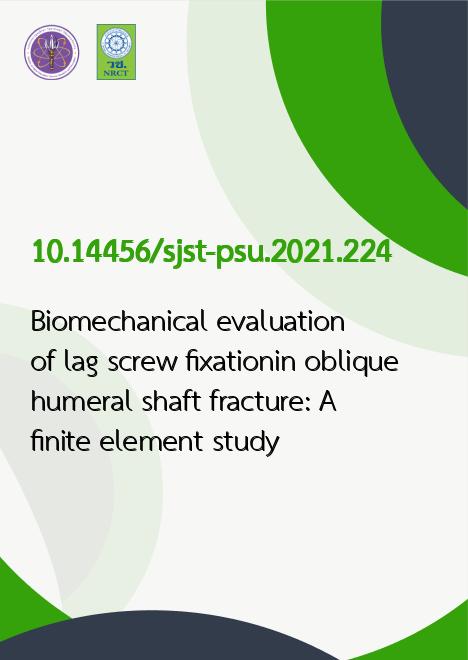
|
Biomechanical evaluation of lag screw fixationin oblique humeral shaft fracture: A finite element study |
|---|---|
| รหัสดีโอไอ | |
| Creator | 1. Phachara Suklim 2. Chaiwat Chuaychoosakoon 3. Atichart Kwanyuang |
| Title | Biomechanical evaluation of lag screw fixationin oblique humeral shaft fracture: A finite element study |
| Publisher | Research and Development Office, Prince of Songkla University |
| Publication Year | 2564 |
| Journal Title | Songklanakarin Journal of Science an Technology (SJST) |
| Journal Vol. | 43 |
| Journal No. | 6 |
| Page no. | 1708-1715 |
| Keyword | long oblique fracture, lag screw and plate fixation, biomechanics, finite element analysis, interfragmentary compression |
| URL Website | https://rdo.psu.ac.th/sjst/index.php |
| ISSN | 0125-3395 |
| Abstract | A common treatment for long bone fractures, namely lag screw and plate fixation, still has relatively high failure rates,especially in case of oblique fracture. The best practice for lag screw fixation condition, i.e. angle, is controversial. Therefore, theaim of this study was to biomechanically evaluate the effect of screw angle conditions on the stability of fixation to determine theoptimal condition using finite element (FE) analysis. The FE models of simplified long bone fracture fixation with various screwangle conditions between 0ยฐ to 60ยฐ were created for analyzing and comparing their fixation performance. The analyses wereperformed under lag screw fixation condition and various load conditions (compression, torsion, and bending loads). The screwwhich installed perpendicularly to the longitudinal axis of bone provided the best performance in terms of generating the highestinterfragmentary compression and performed the best stability while loads applied. |
